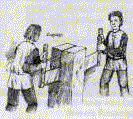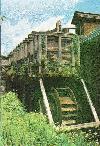
Willkommen auf der genealogischen und historischen Website von Metzenseifen
|
|
|
|
|
|
|
|
|
|
||||||||||||||||||||||||||||||||
| Handwerk | |
|
|
Übersicht |

|
Das Handwerk in Metzenseifen |

|
Berufe und Personen |
|
|
Die Hammerschmieden in M. |

|
Historie der Hammerschmiede |

|
Schema Hammerschmiede |

|
Werkzeuge des Hammerschmieds |

|
Darstellungen Metz. Künstler |
|
|
Typische Erzeugnisse |

|
Hauen (78 Beispiele) |

|
Beile und Krampen |

|
Herstellung der Mistelbacher |

|
Herstellung Rückenschaufel |
Handwerk ⇒ Das Handwerk in Metzenseifen
|
||||||||||||||||||||||||||






 Das Holz wurde mit der "Spannsäge" (spansaw)
geschnitten. Diese Art der Säge ist - ebenso wie der klassische Hobel - noch immer in
Gebrauch. Sie besteht aus einem H-geformten Rahmen mit einem Sägeblatt, das zwischen
die unteren Beine des H eingebracht wird, und einer Seilschleife an der Oberseite.
Ein kurzer, hölzerner Handgriff wird in die Schleife eingesetzt und verdreht, um das
Sägeblatt zu spannen.
Das Holz wurde mit der "Spannsäge" (spansaw)
geschnitten. Diese Art der Säge ist - ebenso wie der klassische Hobel - noch immer in
Gebrauch. Sie besteht aus einem H-geformten Rahmen mit einem Sägeblatt, das zwischen
die unteren Beine des H eingebracht wird, und einer Seilschleife an der Oberseite.
Ein kurzer, hölzerner Handgriff wird in die Schleife eingesetzt und verdreht, um das
Sägeblatt zu spannen.
 Im Jahr 1970 beschrieb Johann Tischler seine frühere Arbeit in einer
Hammermühle folgendermaßen:
Im Jahr 1970 beschrieb Johann Tischler seine frühere Arbeit in einer
Hammermühle folgendermaßen: